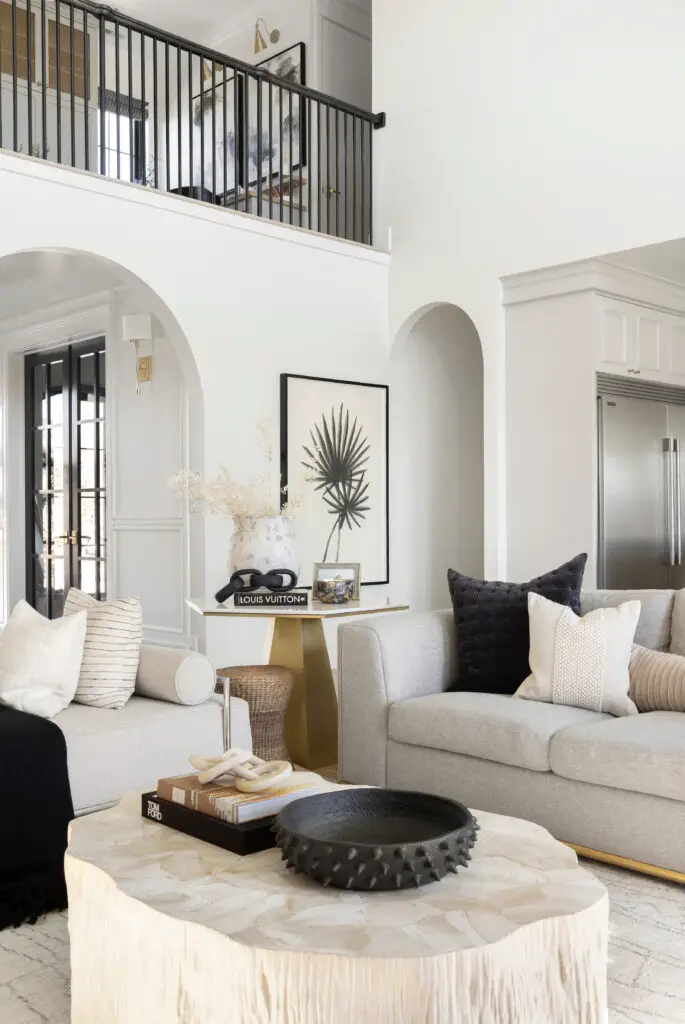
Cooling systems are an essential part of home comfort, but they should never come at the expense of aesthetics. Whether dealing with bulky air conditioning units, exposed ductwork, or disruptive vents, integrating cooling elements into interior design requires thoughtful planning. This is why consulting an HVAC contractor early in the design process is crucial. A professional can help homeowners select solutions that balance efficiency, comfort, and aesthetics, ensuring that cooling elements enhance rather than interfere with the overall space.
used with permission from Andrea West Design
The Design Challenges of Home Cooling
Cooling systems are typically designed with functionality as the priority, often overlooking aesthetics. Traditional HVAC vents, bulky air conditioning units, and exposed ductwork can interfere with carefully planned interiors. Window units obstruct views, and wall-mounted systems may clash with design themes. Even worse, cooling needs sometimes dictate furniture placement, restricting creative layouts. The challenge lies in integrating cooling seamlessly so it enhances comfort while maintaining architectural flow, color palettes, and overall design cohesion.
Cooling systems also impact more than just aesthetics; they shape how people interact with a space. Poorly placed vents can limit where artwork or shelving can be installed. A noisy AC unit can disrupt the ambiance of an open-concept living room. And uneven cooling forces homeowners to make design compromises, such as adding unnecessary ceiling fans or heavy drapes to counteract hot spots.
The biggest challenge is balancing zoning efficiency with design. Many HVAC setups cool homes unevenly, leading to uncomfortable temperature fluctuations and awkward design choices. Smart solutions are needed to ensure cooling functions seamlessly while preserving interior harmony.
used with permission from Andrea West Design
Cooling Solutions That Blend with Interior Design
Ducted mini-split systems, hidden within ceilings or walls, provide efficient cooling without exposing bulky units. Concealed ductwork and linear diffusers offer a sleek and modern aesthetic, blending seamlessly with contemporary designs. Underfloor and radiant cooling solutions eliminate visible components, offering silent and invisible temperature control, making them ideal for high-end interiors. Architectural ceiling fans, crafted from natural wood or sculptural metals, add both style and functionality, complementing a space’s design while improving airflow. For those looking for an even more discreet approach, bespoke built-in AC units can be integrated into cabinetry or millwork, ensuring cooling elements are disguised without sacrificing performance.
Beyond conventional methods, cutting-edge architectural cooling integrations are redefining how temperature control blends into design. Adaptive cooling panels function as decorative wall elements embedded with cooling technology, removing the need for visible vents or ducts. Recessed airflow niches utilize narrow air channels integrated into baseboards or architectural moldings, allowing air to circulate invisibly. Breezeway integration in open-plan homes leverages natural airflow to distribute cool air without the need for noticeable air diffusers.
used with permission from Andrea West Design
Modern Ceiling Fans That Enhance Style and Comfort
Ceiling fans today are far from outdated, clunky fixtures. Minimalist and statement designs, such as matte black, natural wood, or sculptural models, enhance contemporary interiors. High-performance, low-profile models, like hugger fans, integrate seamlessly into modern and low-ceiling spaces. Smart controls, which include automated scheduling and integration with smart thermostats, improve efficiency while maintaining a sleek appearance. Strategic placement of ceiling fans over seating areas or in double-height spaces not only enhances airflow but also makes them functional design elements.
A more refined approach to ceiling fans includes selecting finishes that match existing hardware or light fixtures, creating a coordinated look. Layered airflow strategies use smaller, more discreet fans in tandem with displacement ventilation, reducing the need for oversized units. Directional blade technology allows for precise airflow control, eliminating drafts while ensuring the fan remains an intentional part of the design.
used with permission from Andrea West Design
Using Window Treatments and Shading for Better Cooling
Strategic shading techniques can significantly reduce indoor temperatures without relying on mechanical cooling. Exterior shading solutions, such as awnings, pergolas, and louvers, block direct sunlight before it enters the home, minimizing heat gain. Thermal drapes and honeycomb blinds insulate windows while allowing natural light control. More advanced options include smart tint and electrochromic glass, which adjust transparency for maximum efficiency without visual clutter. Additionally, strategic landscaping, including tall trees and trellises with climbing plants, provides natural shade while enhancing curb appeal.
Beyond traditional shading, tunable glass changes tint based on sun intensity, keeping interiors cool without the need for physical window treatments. Invisible light redirection through prismatic window films bends incoming sunlight upward, preventing heat buildup while maintaining a clean, natural aesthetic. A thermal-zone shading strategy prioritizes shade placement in areas with the highest thermal exposure, optimizing cooling efficiency without excessive window coverings.
Discreet and Stylish Air Conditioning Options
Maintaining a sleek interior while ensuring effective cooling requires creative solutions. Concealed mini-split systems can be hidden in bulkheads, cabinetry, or behind decorative panels, making them virtually invisible. Flush-mounted linear vents seamlessly blend into walls or ceilings, preventing the visual disruption of traditional air vents. Ductless AC systems with custom covers can transform an otherwise intrusive unit into a decorative feature using wood or metal grilles. High-end systems even disguise cooling units behind mirrored or artistic facades, ensuring that they complement rather than detract from the room’s design. Smart airflow systems take discretion a step further by distributing cooled air through nearly invisible slots, eliminating the need for large vents altogether.
For those seeking the most seamless cooling solutions, hydronic ceiling cooling works similarly to radiant heating but in reverse, absorbing excess heat and cooling the space silently. Perforated acoustic cooling panels mimic high-end wall treatments while also acting as an air distribution system. Custom air diffusers can be integrated into textured ceiling elements, lighting fixtures, or shelving, making them part of the décor rather than a mechanical necessity.
Smart Home Tech for Efficient, Clutter-Free Cooling
Smart cooling technology enhances efficiency while maintaining a clean aesthetic. Smart thermostats prevent overcooling through adaptive temperature control, while geofencing and motion sensors adjust cooling based on occupancy, reducing unnecessary energy consumption. Smart vents and zoned cooling systems allow for individualized room control, optimizing comfort and efficiency. Invisible climate control systems, such as smart glass, phase-change materials, and underfloor cooling, operate behind the scenes, eliminating the need for visible cooling components. Voice and app integration further streamline climate management, reducing the need for physical controls on walls.
Passive Cooling Strategies for a Naturally Cooler Home
For those looking to minimize reliance on mechanical cooling, passive strategies offer natural solutions. Cross-ventilation and the stack effect encourage natural airflow through strategically placed windows and vents. Thermal mass materials, such as concrete, stone, and adobe, absorb and release heat to stabilize indoor temperatures. Reflective roofing and cool paints reduce heat absorption, keeping interiors comfortable without additional cooling measures. Shaded outdoor living spaces, including pergolas and green roofs, act as buffer zones to prevent excessive heat gain indoors.
Creating a Cooling Plan That Balances Style and Function
To ensure a home remains both stylish and comfortable, it is essential to integrate cooling into the architectural blueprint from the start. Designing with passive cooling in mind by optimizing layout, window placement, and materials significantly reduces reliance on mechanical systems. Hidden systems, such as concealed ductwork, underfloor cooling, and built-in AC solutions, maintain an unobtrusive presence. Thoughtfully designed elements like stylish ceiling fans, architectural vents, and sculptural diffusers ensure that cooling components enhance rather than detract from a space’s aesthetic. Smart controls automate climate management, offering an efficient and seamless cooling experience. Finally, incorporating natural cooling strategies, such as shading, ventilation, and thermal mass, reduces energy consumption while maintaining a comfortable and visually appealing environment.
The post Cooling Solutions That Work Without Compromising Style appeared first on Decorology.

